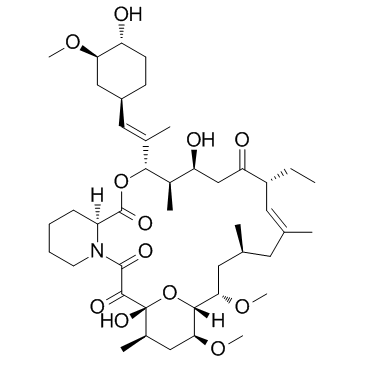An adaptable luminescence resonance energy transfer assay for measuring and screening protein-protein interactions and their inhibition.
Engin Yapici, D Rajasekhar Reddy, Lawrence W Miller
Index: ChemBioChem. 13(4) , 553-8, 489, (2012)
Full Text: HTML
Abstract
Protein-protein interactions (PPIs) are central to biological processes and represent an important class of therapeutic targets. Here we show that the interaction between FK506-binding protein 12 fused to green fluorescent protein (GFP-FKBP) and the rapamycin-binding domain of mTor fused to Escherichia coli dihydrofolate reductase (FRB-eDHFR) can be sensitively detected (signal-to-background ratio (S/B)>100) and accurately quantified within an impure cell lysate matrix using a luminescence resonance energy transfer (LRET) assay. Ascomycin-mediated inhibition of GFP-FKBP-rapamycin-FRB-eDHFR complex formation was also detected at high S/B ratio (>80) and Z'-factor (0.89). The method leverages the selective, stable binding of trimethoprim (TMP)-terbium complex conjugates to eDHFR, and time-resolved, background-free detection of the long-lifetime (∼ms) terbium-to-GFP LRET signal that indicates target binding. TMP-eDHFR labeling can be adapted to develop high-throughput screening assays and complementary, quantitative counter-screens for a wide variety of PPI targets with a broad range of affinities that may not be amenable to purification.Copyright © 2012 WILEY-VCH Verlag GmbH & Co. KGaA, Weinheim.
Related Compounds
| Structure | Name/CAS No. | Molecular Formula | Articles |
|---|---|---|---|
 |
Ascomycin
CAS:104987-12-4 |
C43H69NO12 |
|
Highly specific targeting of human leukocytes using gold nan...
2014-07-01 [J. Biomed. Nanotechnol. 10(7) , 1259-66, (2014)] |
|
Effects of calcineurin inhibitors on an in vitro assay for c...
2005-05-01 [Clin. Exp. Allergy 35(5) , 554-9, (2005)] |
|
The immunosuppressant cyclosporin A antagonizes human formyl...
2006-11-15 [J. Immunol. 177(10) , 7050-8, (2006)] |
|
Study of the effect of Wuzhi tablet (Schisandra sphenanthera...
2010-04-01 [Biomed. Chromatogr. 24(4) , 399-405, (2010)] |
|
Procedure for chromatography involving sample solvent with h...
2008-01-11 [J. Chromatogr. A. 1177(2) , 234-42, (2008)] |